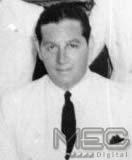Full Name Emilio Bigi Nationality Paraguayan | Name Emilio Bigi | |
 | ||
Notable work “Renacer guarani” (Guarani resurgence) and “Poema sinfonico” (Symphonic poem) Died May 28, 1969, San Cristobal, Venezuela | ||
Emilio Bigi - Cuarteto de Cuerdas Op. 3 en sol Mayor Op 3. 3 - Allegro
Emilio Bigi (July 1, 1910 - May 28, 1969) was the son of Elisa Bigi, from the Italian collectivity in this country.
Contents
- Emilio Bigi Cuarteto de Cuerdas Op 3 en sol Mayor Op 3 3 Allegro
- Make music chicago 2014 project inclusion quartet plays emilio bigi
- Childhood and Youth
- Early moments
- Trajectory Path
- His family
- Last Years
- Work
- References
Make music chicago 2014 project inclusion quartet plays emilio bigi
Childhood and Youth
As a small child, he was part of the “Batallón de exploradores” (Explorers battalion), directed by the Salesiano priest Ernesto Pérez Acosta (Pa’i Pérez), accomplishing the first of his musical studies in the Band of Musicians of this group. Later in life, on he got in the Capital Police Band of Musicians, where he played the bass.
Early moments
Emilio studied the accordion, theory and solfeggio in the Paraguayan Athenaeum and later, the bandoneon. He played this instrument when got in the popular orchestra of Gerardo Fernández Moreno and later on, numerous other groups of popular music, finally forming his own typical orchestra. With this, took part 1940. of the delegation of President Higinio Morínigo, in an official visit to Argentina.
Trajectory / Path
Settled in Buenos Aires, continued to study theory and solfeggio, harmony, contrapunto (counterpoint) and piano, in the Academy Rubbione. There, soon after concluding his courses, presented his thesis about “Variations about a Guarani subject”. Was temporally part of “Trío Guaireño” leadered by Gumersindo Ayala Aquino and later on, formed his own group. With this group he accompany several singers, being part of the Guaraní Folkloric Grouping, which had a prolific activity in the Argentine capital. In 1952, he went on tour with his group of popular music, conformed by Ayala Aquino, Carlos Federico Reyes (“Mita’i churi”) and Paty de Ayala, and settled in San Cristóbal, department of Táchira, Venezuela. In that country developed an intense activity as a musician and teacher, working as a director in the Orfeón of the Alberto Adriani Institute, as a professor in the Music School Miguel Angel Espinel and as an instrumentalist of the Band of Táchira and the Typical Orchestra of the State, without given up on creating music, such as popular, symphonic and camera.
His family
Married with the Venezuelan Carmen Osorio, had two daughters.
Last Years
He died on May 28, 1969, in San Cristóbal, Venezuela. His remains rest in the Venezuelan city.
Work
Among his most representative work in erudite music, are found:
In popular music outstand, because of their beauty and the success the accomplish:
